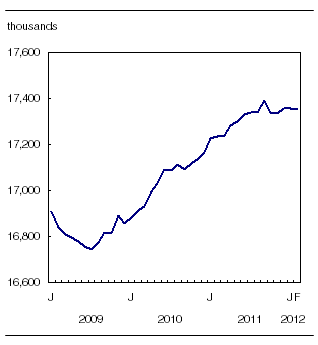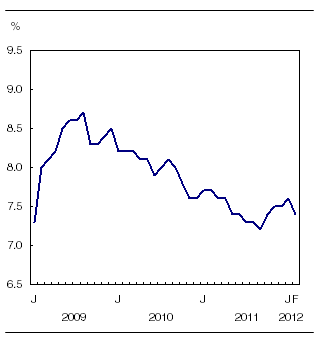Labour Force Survey
Archived Content
Information identified as archived is provided for reference, research or recordkeeping purposes. It is not subject to the Government of Canada Web Standards and has not been altered or updated since it was archived. Please "contact us" to request a format other than those available.
Related subjects
-
[an error occurred while processing this directive]
Employment was unchanged in February. A decline in the number of people searching for work pushed the unemployment rate down 0.2 percentage points to 7.4%. Compared with 12 months earlier, employment was up by 121,000 (+0.7%), with the bulk of the increase occurring in the first half of the period.
Employment

There was little change in full-time and part-time employment in February. Compared with 12 months earlier, the number of full-time workers was up 1.5% (+204,000), while part-time employment declined 2.5% (-83,000). At the same time, the total number of hours worked grew 1.7%, with all of the increase occurring in the first half of the period.
Employment for the month declined in retail and wholesale trade; transportation and warehousing; health care and social assistance; and public administration. These declines were offset by increases in finance, insurance, real estate and leasing; educational services; and business, building and other support services.
Provincially, there was little employment change in February, with the exception of a decline in New Brunswick.
Note to readers
The Labour Force Survey (LFS) estimates are based on a sample, and are therefore subject to sampling variability. Estimates for smaller geographic areas or industries will have more variability. For an explanation of sampling variability of estimates, and how to use standard errors to assess this variability, consult the "Data quality" section of the publication Labour Force Information (71-001-X, free).
Unless otherwise stated, this release presents seasonally adjusted data, which facilitates comparisons by removing the effects of seasonal variations. For more information on seasonal adjustment, see Seasonal adjustment and identifying economic trends.
Statistics Canada is moving to one release time, 8:30 a.m., for all data releases in The Daily. This will mean a change in the release time for the LFS, which is currently 7:00 a.m. This change will be implemented with the release of LFS data on April 5, 2012.
Employment in February fell among youths aged 15 to 24, while it increased among people aged 55 and over. For those aged 25 to 54, employment was unchanged.
Employment was little changed among employees and the self-employed. Compared with 12 months earlier, all of the growth was among private sector employees (+1.4%), while both self-employment (-0.7%) and public sector employment (-0.5%) were down slightly.
Unemployment rate

Chart description: Unemployment rate
Industry perspective
Employment in retail and wholesale trade fell by 37,000 in February. The trend in this industry has been relatively flat over the past three years, with employment fluctuating between 2.6 million and 2.7 million over the period.
The number of people working in transportation and warehousing declined by 22,000, bringing employment in this industry down to a level similar to that of 12 months earlier.
Health care and social assistance also posted a decline in employment, down 22,000, leaving employment in this industry at its level of 12 months earlier.
Employment in public administration declined by 15,000 in February. As a result, employment in this industry was down 1.3% (-12,000) compared with 12 months earlier.
Employment in finance, insurance, real estate and leasing increased by 41,000, offsetting half of the declines that occurred over the previous five months. The number of people working in this industry was 1.2% (-13,000) below the level recorded 12 months earlier.
Employment in educational services increased 17,000 in February, bringing employment growth in this industry to 2.7% (+34,000) over the previous 12 months.
The number of people working in business, building and other support services rose by 16,000 in February. With this increase, employment in the industry was 1.7% (+12,000) higher than 12 months earlier.
Employment in natural resources edged up in February, bringing growth over the past 12 months to 10.2% (+34,000), the highest rate of all industries.
There was little change in construction and manufacturing employment in February. Over the past 12 months, employment in construction increased by 26,000 (+2.1%), while in manufacturing, it declined by 41,000 (-2.3%).
Provincial summary
Employment in New Brunswick declined by 2,600 in February, pushing the unemployment rate up 0.6 percentage points to 10.1%. As a result of this decline, employment in the province was similar to its level of 12 months earlier.
While employment in Ontario was little changed in February, the unemployment rate fell 0.5 percentage points to 7.6%, the result of a decline in the number of people seeking work. Over the past 12 months, employment in Ontario has risen 0.8% (+54,000), with the growth occurring entirely in the first half of the period.
Employment in Quebec was unchanged in February, as was the unemployment rate, which stood at 8.4%. Compared with 12 months earlier, employment in the province was down 1.2% (-49,000).
The number of people working in Alberta was little changed in February, and the unemployment rate was 5.0%, one of the lowest in the country. Over the past 12 months, employment in the province was up 2.8% (+58,000), the highest growth rate of all provinces.
Declines among youths and gains among people 55 and over
Employment among youths aged 15 to 24 fell for the fifth consecutive month, down 27,000 in February, and their unemployment rate was 14.7%. Compared with February 2011, youth employment was down 69,000 (-2.8%). With fewer youths participating in the labour market, their participation rate in February was 63.3%, down from the most recent peak of 68.1% in September 2008.
Among people aged 55 and over, employment rose by 24,000 in February, with most of the increase among men. Over the past 12 months, employment for this age group has grown 4.0%, the highest rate of growth among all demographic groups, and mostly because of population aging.
For people aged 25 to 54, employment was unchanged in February. Compared with 12 months earlier, employment for this group was up 0.6% (+67,000)
Available without charge in CANSIM: tables 282-0001 to 282-0042, 282-0047 to 282-0063, 282-0069 to 282-0095 and 282-0100 to 282-0121.
Definitions, data sources and methods: survey number 3701.
A more detailed summary, Labour Force Information (71-001-X, free), is now available online for the week ending February 18. From the Key resource module of our website under Publications, choose All subjects, then Labour.
Data tables are also now available online. From the Subject module of our website, choose Labour.
The next release of the Labour Force Survey will be on April 5.
For more information, contact Statistics Canada's National Contact Centre (toll-free 1-800-263-1136; 613-951-8116; infostats@statcan.gc.ca), Communications Division.
To enquire about the concepts, methods or data quality of this release, contact Lahouaria Yssaad (613-951-0627; lahouaria.yssaad@statcan.gc.ca) or Jason Gilmore (613-951-7118; jason.gilmore@statcan.gc.ca), Labour Statistics Division.
- Date modified:
